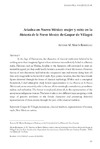Please use this identifier to cite or link to this item:
https://accedacris.ulpgc.es/jspui/handle/10553/71882
| DC Field | Value | Language |
|---|---|---|
| dc.contributor.author | Martín Rodríguez, Antonio María | en_US |
| dc.date.accessioned | 2020-04-30T15:49:04Z | - |
| dc.date.available | 2020-04-30T15:49:04Z | - |
| dc.date.issued | 2012 | en_US |
| dc.identifier.issn | 1889-5611 | en_US |
| dc.identifier.other | WoS | - |
| dc.identifier.uri | https://accedacris.ulpgc.es/handle/10553/71882 | - |
| dc.description.abstract | In the Age of Humanism, the characters of classical myth were believed to be nothing more than imaginary figures whose existence was exclusively linked to a literary realm. Heroines such as Medea, Ariadne or the Amazons still continued to exert an irresistible appeal, yet they could hardly be taken as models of real-life women. However, the era of new discoveries laid before the conquerors' eyes real women doing feats till then only imaginable in the world of myth. Epic poems, however, describe these female figures distorted through the lenses of classical mythology. Within such a conceptual framework, I shall attempt to study female representation in La Historia de la Nueva Mexico and, more concretely, refer to the use of two seemingly contradictory procedures: realism and stylization. The former is employed, above all, in the representation of the anonymous indigenous woman. The latter works in two different ways: assigning a wide range of positive attributes to the female characters and presenting distorted representations of them, woven through the yarn of the classical tradition. | en_US |
| dc.description.abstract | El hombre del humanismo consideraba ya a los personajes del mito figuras imaginarias con una existencia únicamente ligada a lo literario. Heroínas como Medea, Ariadna o las Amazonas seguían teniendo un atractivo irresistible, pero difícilmente podía considerárselas modelos de mujeres realmente existentes. Sin embargo, la época de los descubrimientos puso ante sus ojos mujeres auténticas que realizaban hazañas hasta ahora sólo pensables en el mundo del mito. Su plasmación en la épica, con todo, se verá teñida por el filtro literario del mito clásico. Dentro de este marco conceptual, estudiamos la representación de la mujer en La Historia de la Nueva México y el recurso a dos procedimientos descriptivos aparentemente contradictorios: el realismo, sobre todo en la presentación de la mujer indígena anónima, y la estilización, que opera en dos sentidos: la atribución de todo tipo de cualidades y la representación deformada a través del filtro de la tradición clásica. | en_US |
| dc.language | spa | en_US |
| dc.relation.ispartof | Camino Real-Estudios De Las Hispanidades Norteamericanas | en_US |
| dc.source | Camino Real-Estudios De Las Hispanidades Norteamericanas [ISSN 1889-5611], v. 4 (6), p. 23-41 | en_US |
| dc.subject | 55 Historia | en_US |
| dc.subject | 570107 Lengua y literatura | en_US |
| dc.subject.other | Gaspar De Villagra | en_US |
| dc.subject.other | Humanism | en_US |
| dc.subject.other | Classical Tradition | en_US |
| dc.subject.other | Representation Of Women | en_US |
| dc.subject.other | Myth | en_US |
| dc.subject.other | New Mexican Natives | en_US |
| dc.subject.other | Gaspar de Villagrá | en_US |
| dc.subject.other | Humanismo | en_US |
| dc.subject.other | Tradición clásica | en_US |
| dc.subject.other | Representación de la mujer | en_US |
| dc.subject.other | Mito | en_US |
| dc.subject.other | Indígenas nuevomexicanos | en_US |
| dc.title | Ariadna en Nuevo México : mujer y mito en la "Historia de la Nueva Mexico de Gaspar de Villagrá" | en_US |
| dc.title.alternative | Ariadna in New Mexico : Woman and Myth in the "History of New Mexico" by Gaspar de Villagra | en_US |
| dc.type | info:eu-repo/semantics/Article | en_US |
| dc.type | Article | en_US |
| dc.identifier.isi | 000408805000002 | - |
| dc.description.lastpage | 41 | en_US |
| dc.identifier.issue | 6 | - |
| dc.description.firstpage | 23 | en_US |
| dc.relation.volume | 4 | en_US |
| dc.investigacion | Artes y Humanidades | en_US |
| dc.type2 | Artículo | en_US |
| dc.contributor.daisngid | 6425620 | - |
| dc.description.numberofpages | 19 | en_US |
| dc.utils.revision | Sí | en_US |
| dc.contributor.wosstandard | WOS:Rodriguez, AMM | - |
| dc.date.coverdate | 2012 | en_US |
| dc.identifier.ulpgc | Sí | es |
| dc.description.esci | ESCI | |
| item.grantfulltext | open | - |
| item.fulltext | Con texto completo | - |
| crisitem.author.dept | GIR Estudios sobre humanismo, filología y pervivencia clásicas y literatura canaria | - |
| crisitem.author.dept | Departamento de Filología Hispánica, Clásica y de Estudios Árabes y Orientales | - |
| crisitem.author.orcid | 0000-0003-1418-8334 | - |
| crisitem.author.parentorg | Departamento de Filología Hispánica, Clásica y de Estudios Árabes y Orientales | - |
| crisitem.author.fullName | Martín Rodríguez, Antonio María | - |
| Appears in Collections: | Artículos | |
Page view(s)
98
checked on Sep 28, 2024
Download(s)
40
checked on Sep 28, 2024
Google ScholarTM
Check
Share
Export metadata
Items in accedaCRIS are protected by copyright, with all rights reserved, unless otherwise indicated.
